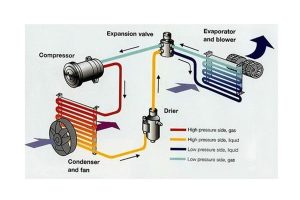A car’s air conditioner system is the biggest respite to every car owner driving in the summer heat. When the blazing sun is on your head, and you are escaping the sweaty days, nothing is sweeter than the chilly, air blast from the A/C. However, no matter how much we hail the cold air, it needs repair, maintenance, and care to continue providing high-quality service. Moreover, no ice-machine or a grumpy goblin is fanning you on the summery afternoons, but a very intricate and carefully curated aircon system that works through a compressor, condenser, evaporator, and many others. If you have ever wondered how a car air conditioning works, your answer lies below.
We have curated this extensive article on the car air conditioner, detailing vehicle air conditioning.
Without any further delay, let’s get started.
How does the Car Air Conditioner work?
As mentioned, the working of the air conditioner is a complicated one, but nothing so difficult that you cannot make sense.
The air conditioner system has five major components:
- Compressor
- Condenser
- Receiver Dryer or Accumulator
- Expansion Valve/Orifice Tube
- Evaporator
If you have questions like how does a compressor work in a car or what is an A/c condenser used for a car, this car air conditioner guide will solve everything.
 The entire process starts with the refrigerant – the famous car air conditioning gas. Once you crank up the air conditioner system, the refrigerant travels to the condenser. Here, the fresh air from the atmosphere also passes through the car air conditioner condenser, allowing the gas to experience a drop in temperature and turn liquid. The process works on changes in pressure, resulting in a change in the temperature.
The entire process starts with the refrigerant – the famous car air conditioning gas. Once you crank up the air conditioner system, the refrigerant travels to the condenser. Here, the fresh air from the atmosphere also passes through the car air conditioner condenser, allowing the gas to experience a drop in temperature and turn liquid. The process works on changes in pressure, resulting in a change in the temperature.
The resultant liquid then goes through the receiver dryer which removes the contaminants, impurities and any moisture. From thereon, the liquid travels to the thermal expansion valve where the flow changes as per the temperature control adjusted by you, causing it to lose pressure and temperature. By this time, the refrigerant has turned into a gas again and passes through the evaporator coils.
The liquid is then turned into a vapour as it passes through the evaporator coils, which subsequently gets blown into the cabin as cool air.
Now that you have a brief overview of how a car air conditioner works, it is time to look at the individual components of the air cooling system in the engine.
What is the Compressor?
Wondering what a compressor does in a car?
The Compressor is known as one of the most essential parts of auto air conditioning. It’s main purpose of this particular component is to pressurize the refrigerant that cools the air. The winding (serpentine) belt that is responsible for many crucial components is also responsible for the compressor.
What is the Condenser?
The car air conditioner condenser is the place when the hot refrigerant gas turns into liquid. It is found in front of the radiator, reducing the temperature and pressure as it moves to the next step.
What is a Receiver/dryer or Accumulator?
The receiver/dryer is a part of the auto air conditioning system and is present on vehicles where there is a thermal expansion valve. The role of the particular component is to contain the liquid and separate it from the gas, remove the moisture, and strain the contaminants.
If your car contains an orifice tube instead of a thermal expansion valve, the automotive air conditioning system will have an accumulator instead of a receiver/dryer. The job of an accumulator is similar to that of the receiver/dryer.
What is a Thermal Expansion Valve/Orifice Tube?
The car air conditioner parts also include the Thermal Expansion Valve or Orifice Tube which is situated between the condenser and the evaporator. It monitors the pressure and temperature of the car air conditioner system and then decides the quantity of refrigerant that can enter the evaporator.
What is an evaporator?
The evaporator is the last step in the car conditioner system and is responsible for cooling air and removing moisture.
What is Refrigerant?
Refrigerant is a compound available in a fluid or gaseous state and is capable of absorbing heat from the environment. The compound is present in air conditioners inside copper coils, and as it encounters the heat, it gets converted from a low-pressure gas to a high-pressure liquid. I am sure you are aware of the rest of the air-conditioning cycle followed through different components.
What is Air-conditioner Recharge/Re-gassing?
Like every other car part, your air conditioner also needs to be maintained and serviced for optimum performance. One of the most common services demanded by the car air conditioner is the recharge or re-gassing of refrigerants. The need for recharge is evidently expressed with the drop in the performance.
It is natural that your car loses refrigerant gas overtime which happens due to the use of rubber hoses and aluminium pipes used in the system. It might also malfunction after the long pause in usage during the winter season.
However, the air conditioner system cannot work efficiently unless there is the required level of refrigerant.
Bring in your car for an air-con recharge every two years, or whenever you see a dip in the performance. During the re-gassing procedure, a performance test is carried out along with a vacuum leak check and a pressure leak check. It is also a good way to decontaminate the system as it is quite prone to bacteria and moulds.
Car Air Conditioner Service
Now that you have a fair idea about how an air conditioner works and its many different components, let’s talk about servicing and maintenance. Car air conditioning repair is extremely essential, especially if you don’t want the blast of hot, humid air in your face during summers.
The most obvious sign of taking your car to a service centre to get the air-con repaired is when you feel it is not cooling enough. I mean, that’s the job of the air-conditioner, right?
After getting it to the service centre, you can either just get it recharged or go for the full service.
To ensure everything is working fine with the air-con system, the condenser is inspected and checked. Next, the air-conditioner pipes and pollen filter are inspected. In the end, all the replacement work is carried on with a decontaminating session.
This was all about the car’s air conditioner system. Hope you found this informative and interesting. For more such articles, keep watching this space.
For your aircon service needs contact us now on: 0800 772 3070 or email us on: info@autocoolaircon.com.
